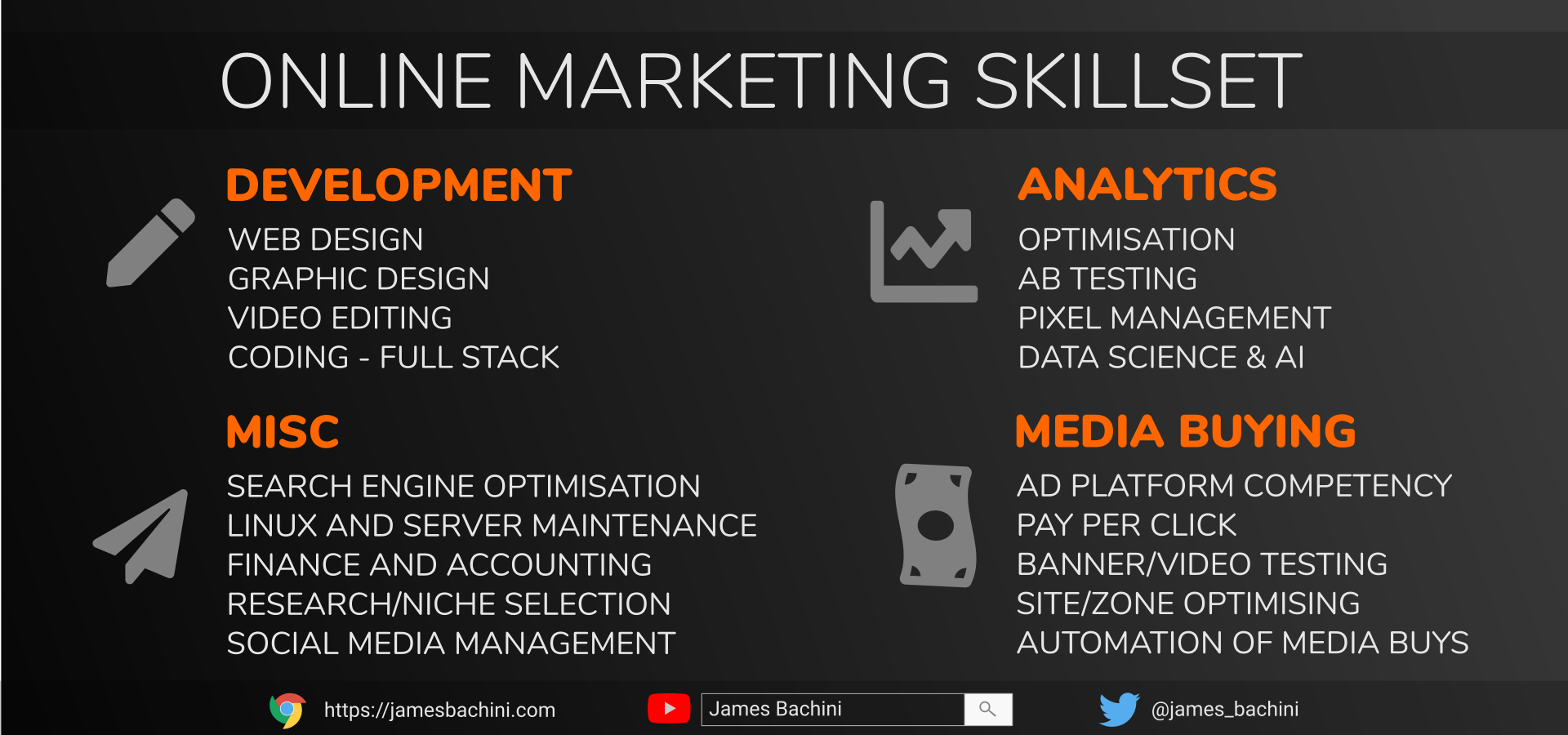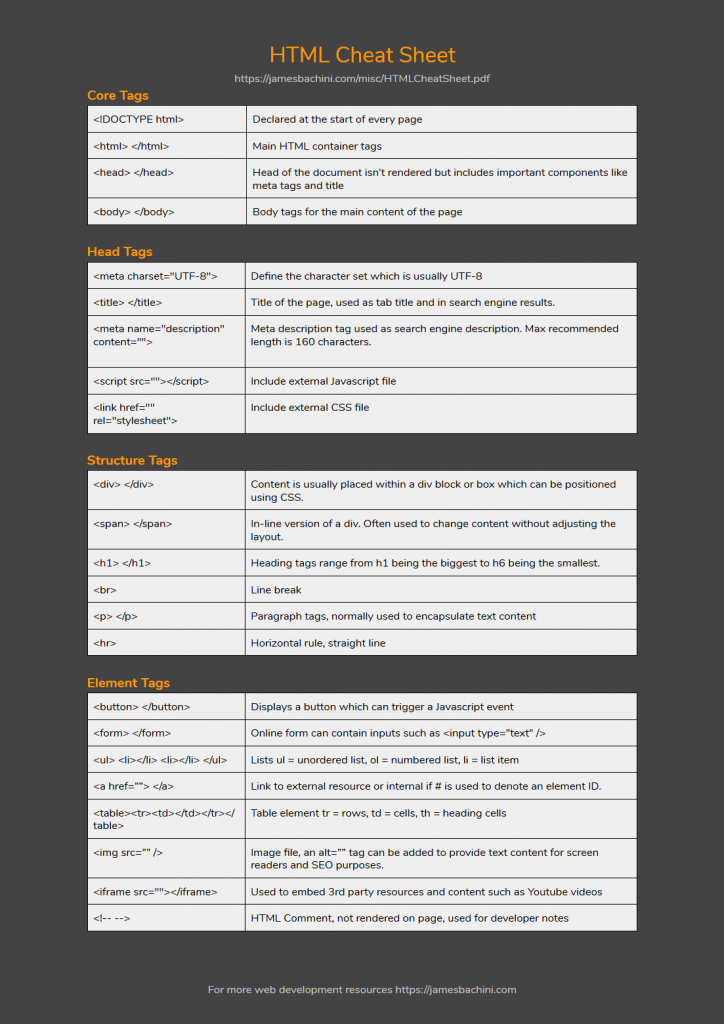This article is part of a free online course where you can learn digital marketing.
Introduction
In this document I explain how online marketing works, provide online marketing tips and show how online marketers make money. There is a deep dive into building web properties, which traffic sources are being used and how to scale and compete in the online marketing space.
- Introduction
- Building a Website
- Tracking & Analytics
- Traffic Sources
- Design
- Monetisation
- Scaling Up Challenges
- Corporate Online Marketing
- Independent Online Marketing
- Competing at the highest levels

Online Marketing in the 2020’s
Online marketing has evolved at a fast pace since I started running ads around 2005. Methods advance, niches come and go, traffic sources and windows of opportunity are constantly changing.
Competency in online marketing requires a broad set of skills and knowledge to be able to run effective campaigns either individually or as a team.

Performance Marketing
The biggest difference between traditional marketing and online marketing is the performance aspect. Performance marketers apply scientific methods to their promotions, constantly improving and learning from what they are doing. If banner ad A gets more clicks than banner ad B, more variations of banner ad B will be designed and the test will restart.
Another good example is approaching a new and unfamiliar niche. A lean methodology can be used to test a value proposition. Say a client wanted to sell bottles of lemonade online. The first thing I would do is drill down on the benefits of the offer. Put those benefits into different ads and landing pages. Then split test the ads and the landing pages giving each equal traffic. Key performance metrics can be tracked to give an indication of which benefits appeal to the market. From this starting point the campaign can be expanded and constantly improved through continuous A/B testing.
Building a Website
Websites and landing pages (a single page site) are the real estate of the internet. Websites with lots of traffic in popular niches are highly valuable in much the same way that shops on busy streets are.
Very often a performance marketer will add a landing page between the traffic source and the final offer. A landing page can be split tested quickly and efficiently to increase conversion rate over sending the visitor directly from the traffic source to the final merchant site. Landing pages can be used to test different selling angles, collect data such as building an email list or to track performance which may not be possible on a 3rd party offer such as an affiliate offer where the affiliate owns the landing page but the merchant owns the final destination website.
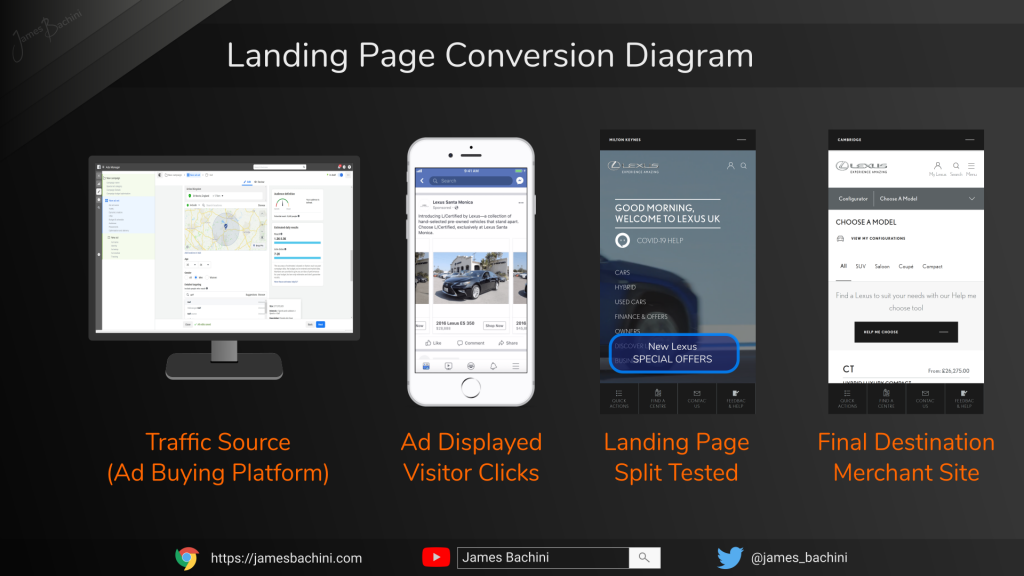
In this section I’m going to give an overview of the tools that marketers can use to create sites and landers.
WordPress
By far the most popular content management system on the web powering approximately 36% of all websites. WordPress makes it easy to create and build a website with no coding knowledge.
You can simply find a web host online, do a one click wordpress install and have a site up in minutes. Choose a theme, add some plugins and use the simple word processor style editor to create a website.
There is of course some downside in that wordpress makes it very fast and easy to get a great looking site but if you want minor tweeks it gets complicated quickly. Want to move your logo a few pixels to the left, you’ll probably need to dig into the code. Which brings me nicely to…
HTML, CSS & Javascript
These are the three languages of the internet and are used a lot in online marketing.
HTML is the core markup that structures every web page. It’s a tag based language and looks like this.
<html>
<h1>Header</h1>
<p>Paragraph</p>
</html>
Where most elements have an opening tag and a closing tag encapsulating content.
HTML sits between the html tags, the header sits between the h1 tags (change this to h2 and you have a subheading), and a paragraph of text will sit between p tags. Download this HTML cheat sheet for all the different tags and you now know HTML. It’s that simple.
CSS is the styling code that all websites use. Want to change a font size, make something bold, tweek a colour or fit a background image? Then you’ll be using css. It’s basic components are intuitive and easy to learn. Let’s take the previous example and add some CSS style.
<html>
<style>#my-paragraph { font-size: 24px; color: red; }</style>
<h1>Header</h1>
<p id=”my-paragraph”>Paragraph</p>
</html>
The CSS code is contained within <style> HTML tags to tell the browser that it’s CSS. We give the paragraph element an ID of “my-paragraph” and then reference that in the CSS. We change the font size and font color using CSS code.
Javascript is the most versatile programming language on the planet. You can build websites, mobile apps, desktop programmes, API’s and microservices. It’s more complex to learn than HTML but is a natural step up for people who are working with online content.
Javascript enables code to be executed within the browser. This means you can run calculations, store data, fetch 3rd party data, render web page content all from the code that is delivered with the HTML web page. Let’s add some Javascript to the original example.
<html>
<h1>Header</h1>
<p>Paragraph</p>
<script>
var myNumber = 1 + 2;
document.write(myNumber);
</script>
</html>
In this example we encapsulate the Javascript code within HTML script tags. We add 1 + 2 and store the value 3 in a variable called myNumber. We then use the document.write() function to print it out.
That’s a very quick overview which is aimed at making the process of learning to code and web development less daunting.
So which one should an online marketer learn? All of them. Start with HTML, then use CSS to make it look pretty and then move on to Javascript. You can learn the basics in a day which will allow you to read other peoples code and understand the building blocks that make websites work. Learning to code is a massive advantage in the online marketing space.
Try experimenting with the bits of code above here: https://codepen.io/pen/
Tips for building websites and web development
- Start with a template or boilerplate which will take care of a lot of the technical aspects.
- Anything you don’t know how to do, search Google and copy and paste from stackoverflow.
- Use a good text editor like VSCode
- Use wireframing software like Adobe XD to create a clear picture of what you are trying to achieve before you start coding.
- Use colour scheme picking sites like coolors to come up with design colours.
- Keep it simple, less is more with modern UI design
- Design websites and apps for mobile first, it’s easier to expand a design for desktop than it is to shrink it for mobile.
Tracking & Analytics
KPIs
The first thing to assess before we get into tracking is what are your key performance indicators? What would make this online marketing campaign successful for you?
Is it new clients, online orders, email sign ups or something else entirely? It will change from campaign to campaign but there is always a way to track the data and optimise accordingly.
Companies like Shopify add value by taking care of the tracking systems. You simply copy an analytics reference and a facebook pixel reference over and the platform takes care of the rest.
When setting up tracking ourselves we need a few things.
Google Analytics

There are alternatives but nothing comes close in my opinion to Google analytics for the amount of data, visualisations and cost (it’s free). Adding Google analytics to your site is straightforward and once it’s done there’s a couple of pro tips you should know about.
Use the following tags on your urls to track individual traffic sources, mediums and campaigns
- utm_source = Traffic Source
- utm_medium = Advertising Medium
- utm_campaign = Ad Campaign
So we can add these URL parameters to our website when we give out any links and the data will be recorded in analytics.
https://mysite.com/?utm_source=facebook&utm_medium=video&utm_campain=fb1
The second thing is goals. We can fire goals from within Javascript code anywhere on the site. Want to track how many users from each traffic source click a specific button? Add the following code to the onclick event:
ga(‘send’, ‘event’, MySite’, ‘click’, ‘CTA1’, 1);
Pixels
The second thing we need is traffic source pixels. These will measure conversion data directly on the traffic sources self-service platform. They can also be leveraged to do retargeting campaigns, showing ads to people who previously visited your site.
Facebook and Google Ads both have exceptional pixel tracking technology and I’d recommend installing both on any campaign you run.
Machine Learning in Online Marketing
Leading ad platforms are using machine learning to automate targeting across their inventory. By feeding the pixels conversion data we essentially train the pixel to let it know what type of customer we want.
The end goal of this is to run a broadly targeted campaign with the pixel using behind the scenes AI models to select the best inventory for your advertising campaign. This does however take some time and it works best when you have multiple events setup such as page view, click, add to cart, checkout etc. Simply put you feed the traffic network conversion pixel data and it optimises your campaigns for you.
Micro conversions
Micro conversions are small conversions such as a page scroll or button click. They can be used to optimise traffic sources and landing pages more quickly than solely focusing on core KPI’s. Learn more about micro conversions here.
Traffic Sources
Pay Per Click (PPC)
When there is existing demand for a product or service then PPC is hard to beat. A consumer searches Google for what they want. A marketer bids on the relevant keywords and their ad which resembles a search result gets pushed to the top of the listings.
Google Ads is the main player with approximately 90% of the traffic. Bing Ads is in 2nd place and has much less competition and volume.
Google Ads has a number of options when you first set up a campaign including “Search” which is PPC.
Advice for running PPC.
- Untick the “include Google search partners” box
- Always set a budget per day and maximum click cost
- Use the +keyword modifier by adding + before each keyword. Prevents related phrase matches which tends to lower traffic relevance
- Use clickbaity headlines and descriptions, your clickthrough rate is critical to your relevancy score so you want to do everything possible to increase the clicks on your ad
- Use the search terms report to build negative keyword lists and block any non-relevant searches
- Keep ad groups small with 5-10 very closely related keywords or keyword pairs. Break a campaign down to multiple ad groups and copy and paste ads between them.
- Once profitable, lift budgets, bids and expand keywords to more broad phrases.
Display Ad Exchanges
Display traffic is most often associated with banner ads however in 2020 there is much more variety as advertising evolves to find new ways to capture attention.
Common placements now include
- Static and animated banners
- Video Ads
- Push notifications
- Pop unders
- Interstitial Ads
- Page Takeover
- Native Ads
Google again is the big player in this market with their Adsense and Doubleclick programmes monetizing the majority of publisher traffic. This is then sold through the google ads platform as part of the Display Network traffic as well as being resold through numerous 3rd party ad-exchanges and demand side platforms (DSP’s).
Not all display traffic is created equally and it’s important to segregate mobile app traffic, which includes a lot of accidental clicks from website traffic. Both are absolutely riddled with fraud and botnets making it one of the harder traffic sources to get working.
My advice here is to look for large websites in your niche and see who runs their ads. For example in the cryptocurrency niche you might look at coinmarketcap and see that buysellads.com runs their banners. You can set up an account here and just purchase ads on that site. Doing this limits your reach but increases your chances of initial success compared to run of network (all publishers) campaigns.
Many display networks, including Goggles, leverage demographic and interest data which allows a media buyer to drill down on targeting and reach a more specific audience. A more targeted audience will usually equate to better metrics across the campaign and ultimately higher return on ad spend (ROAS).
Social Media
Social media marketing is another form of disruptive online marketing that aims to capture the attention of users who are browsing popular social media sites like Facebook, Instagram, Snapchat, Twitter, Tiktok and Linkedin.
Instagram is owned by Facebook which gives them the lion’s share of this market. There has never been an advertising platform with targeting like Facebook. You can niche down to men aged between 35 and 36 who are married, living in a specific town, who like rock music and also playing golf. The laser targeting of the platform has caused PR problems for the social media giant but to marketers it is a gold mine.
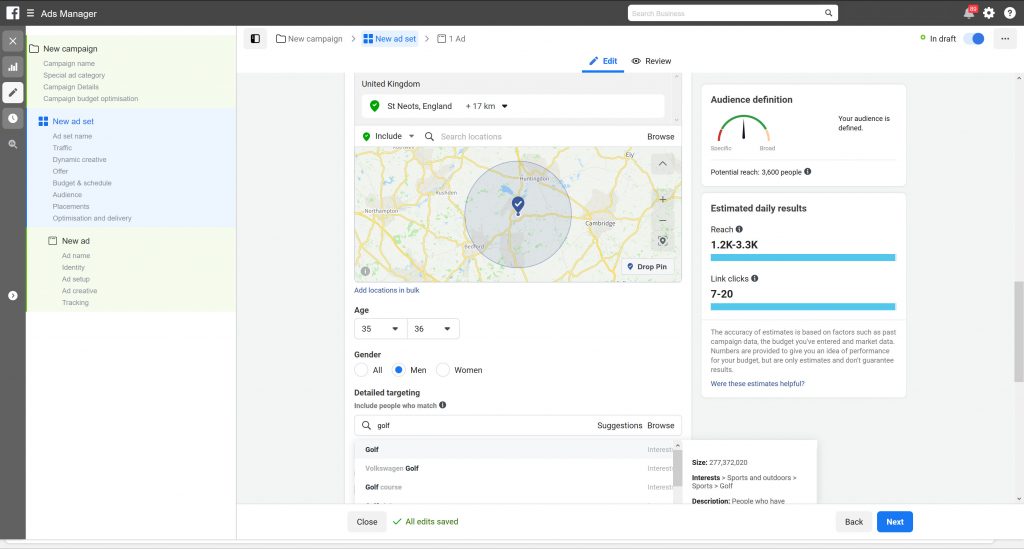
Facebook is probably the number one advertising platform for affiliates and drop shippers because the targeting options offer so much room for high performance marketers to excel.
Search Engine Optimisation (SEO)
SEO is a marathon rather than a sprint. The basic principle is that you create great content. Google recognises this, lists you at the top of the organic search results and your site gets inundated with free traffic… but in the real world.
SEO marketers will create long form content in the form of 1000-3000 word articles answering well researched queries where the search demand is high but competition from other websites is low. They will provide rich media such as images, videos, infographics, original research, tables, charts, graphs all of which are designed to gain backlinks.
Google has 100’s of ranking factors but links back to your site from 3rd parties (backlinks) are the most important. Social signals, chrome visits, brand searches, internal linking, keyword density all plays an important role. In 2020, a quarter of a century after the original Google algorithm was released, still nothing compares to getting an authority backlink to your site, for moving up the SERP’s (search engine results pages).
| For more information on how Google assesses the quality of web pages get a strong coffee and go read the latest “search quality evaluator guidelines”. Google periodically updates this fairly technical 150 page document to outline how their manual reviewers should rank websites. Read it and then study what changes in every update which is widely commentated on throughout the SEO community. Optimising for manual review and real users is more important than optimising for the algorithm in my opinion. | 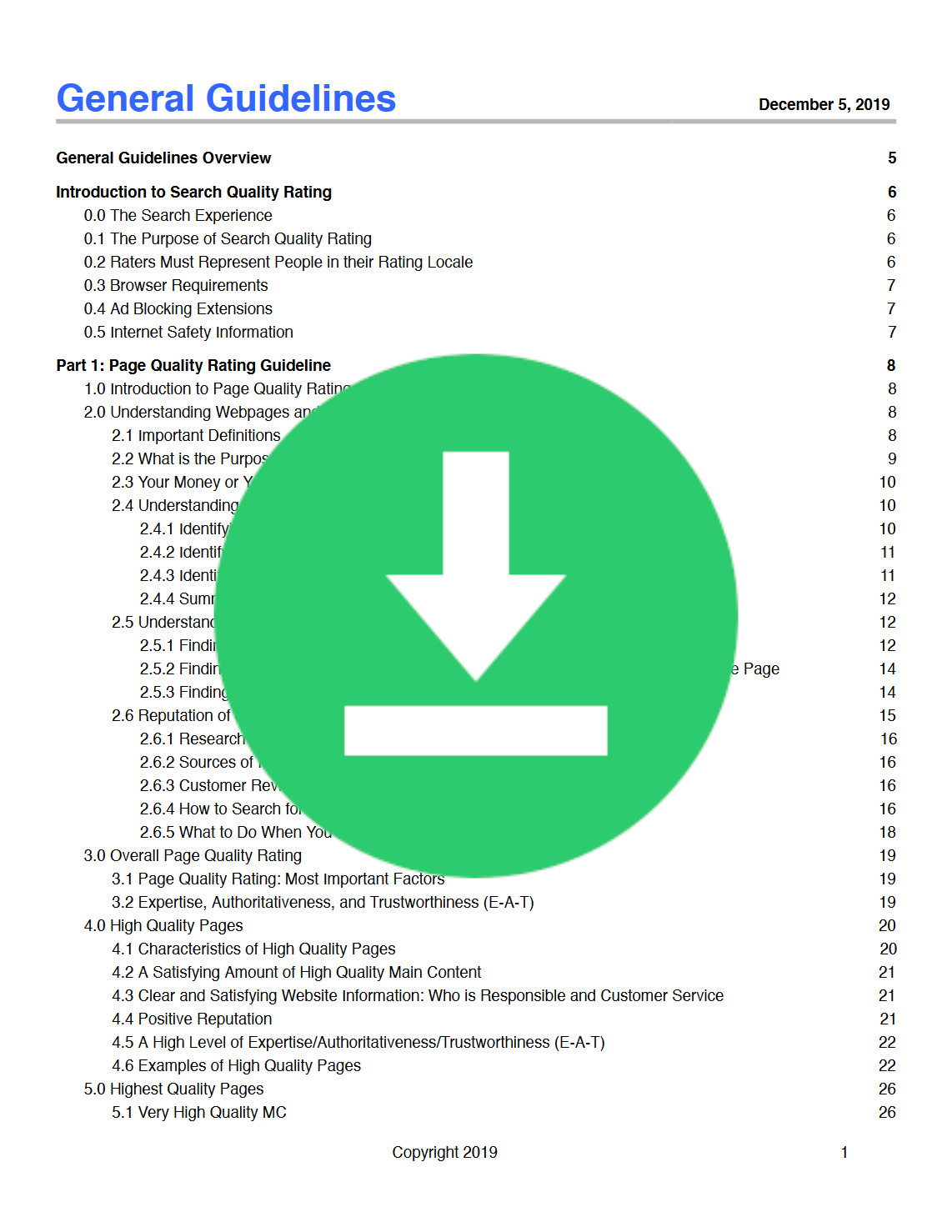 |
Having said that backlink profile is still critical to success. Backlinks are counted as weighted votes for your website.
How do we get backlinks?
I’ve found the best way is to create exceptional content and then run ads on paid traffic sources to the content. This creates a seed audience from which a new site can grow. The “build it and they will come” thing doesn’t work, it just doesn’t. You end up building something and no one cares.
Paid traffic and a significant launch budget for the first six months to a year will create an initial audience to a website and some of these users will naturally build the exact backlink and social signal profile that Google is looking for. Once you get the rankings you want it’s time to ease off the ads slowly and the site will continue to get free traffic from the organic listings and you’ll have a moat against competitors.
All this relies on outstanding content. If your content isn’t incredible then no one will want to link to it. This article is an example of providing content to the best of my ability, it will then be seeded and eventually rank in the SERP’s with a bit of luck. A good time to ask if you appreciate this article and think others would too could you share it?
The biggest individual affiliate I ever heard about (from a reputable source, as opposed to a conference keynote speaker selling an ebook) was an email marketer. Apparently he was running $1m in revenue per month back in 2013. That was just with one of the CPA networks he would have been working with and little to no overheads.
So there’s undoubtedly money in email marketing and building a list.
Tips for building an email list
- Use a lead magnet, give away a report, a pdf, a video in exchange for an email address
- Use an email sending service like Sendgrid, Amazon SES or Mailchimp.
- Manage your list and remove bounced addresses and filter any bad addresses like mailinator.com
- Target a delivery rate above 95%, this requires opt-in or engaged audiences
- Target spam report and unsubscribe rates below 0.5% by making your content valuable.
Design
For some people design comes more naturally than others. If you aren’t into the latest fashions, develop back-end code and use Android rather than Apple products then, like me, you’ll probably have to work harder at it to get it right.
Imitation is better than reinventing the wheel. Find landing pages, websites, logos you like and practice by trying to copy them or recreate variations of them for your own marketing. Like anything the more practice you get the better you’ll be.
Graphics Design
For most graphics I break down what I am doing into two categories.
- Photo editing – I use Gimp but Photoshop is the obvious choice
- Everything else – I use Inkscape to create SVG graphics
Inkscape and SVG graphics are revolutionary, I can’t stress how much of a difference this free, open-source software has made to my own design skills. SVG’s are formed of shapes, solid lines, colours and gradients. It’s no good for photo editing if you want realistic images but for logos, icons, diagrams, isometric drawings, infographics and data representations it is brilliant.
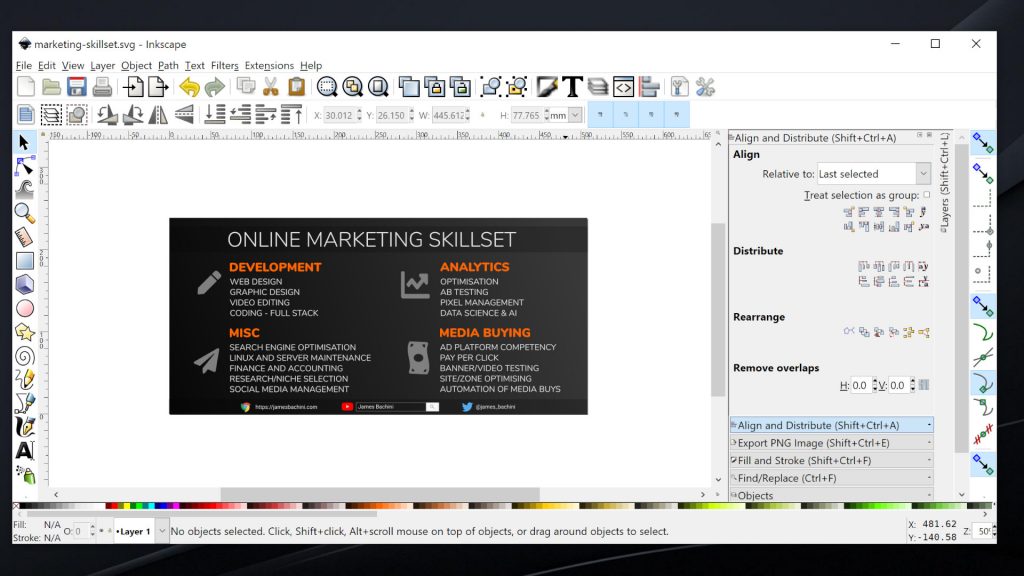
Canva is also worth a mention as it’s very good for editing images quickly from templates for social media posts.
Landing Page Design
Nothing beats coding in a text editor such as VSCode. But for non-coding online marketers there’s wordpress which you can do pretty much anything with.
A standard landing page should have a hero shot of someone enjoying the product, a list of benefits (not features), a core value proposition headline and a big call to action button. Perhaps a video explainer as well for certain niches.
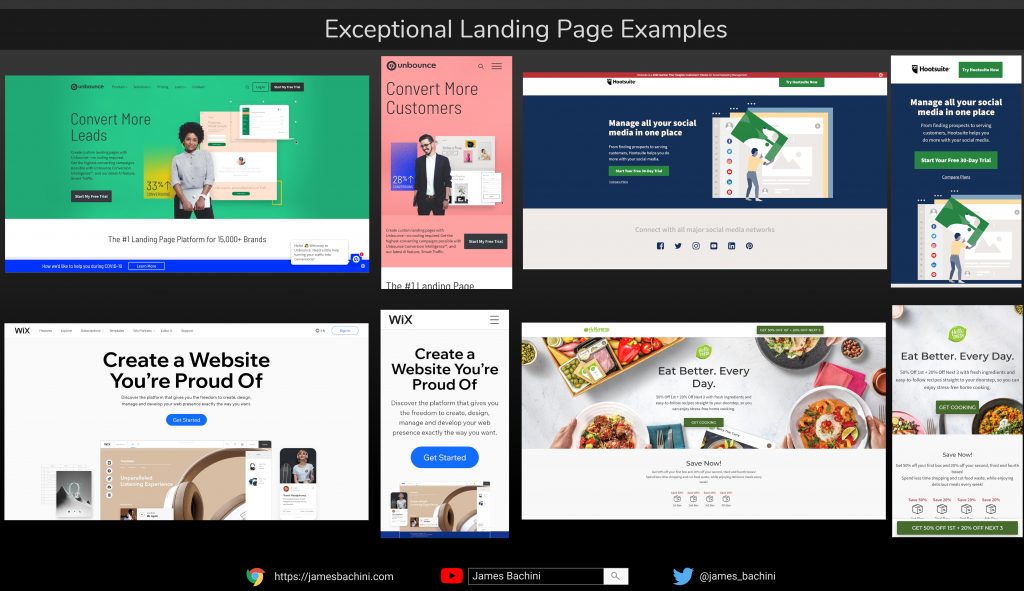
The design should be responsive and look good across all devices. A good way to test what your site looks like on different mobile devices is to open up Chrome and hold down CTRL+SHIFT+J or CMD+SOMETHING+J on Mac which will open up a developer console. You can then click the little mobile icon at the top and select different devices to emulate while browsing your site.

Great design is important and will play a huge role in your conversion rates. Even if you are using a CMS like WordPress it wouldn’t hurt to learn some HTML & CSS so you can move things around within the platform.
Take note of page load times when running performance marketing campaigns. A 0.1 difference in page load time led to a 7% increase in revenues according to a recent study by Google. The worst offenders here are Javascript frameworks like Vue.js, Angular and React. These create bulky bloated packages which are fine for apps but far too slow and inefficient for performance marketing.
Landing pages should always be evolving and AB tested to improve performance. We will look at this in further detail later. Even if we are just throwing up a quick lander using a lean methodology to test a new concept or business idea, it’s worth AB testing a couple of different angles. By testing different value propositions, the money being spent on ads is buying data even if the campaign isn’t profitable.
Website Design
When designing a website for an online marketing campaign the first step is to think about key performance indicators. What does the website need to achieve? In this section we’ll look at different site goals and how best to achieve them.
 | SEO Sites – To generate organic traffic through SEO, the site should be built like a silo and organised into topics with 3 tiers.Level 3. Question & answer posts – answering common queries with low competition. Usually 500-1000 words.Level 2. Standard SEO posts – 1000-2000 word posts which contain great content and provide the best resource for the targeted queryLevel 1. Pillar Posts – These will be the posts that target the keywords the site was built for. Pillar posts provide exceptional content, collections of internal links out to standard posts in the same topic and a wide variety of linkbaity rich media. |
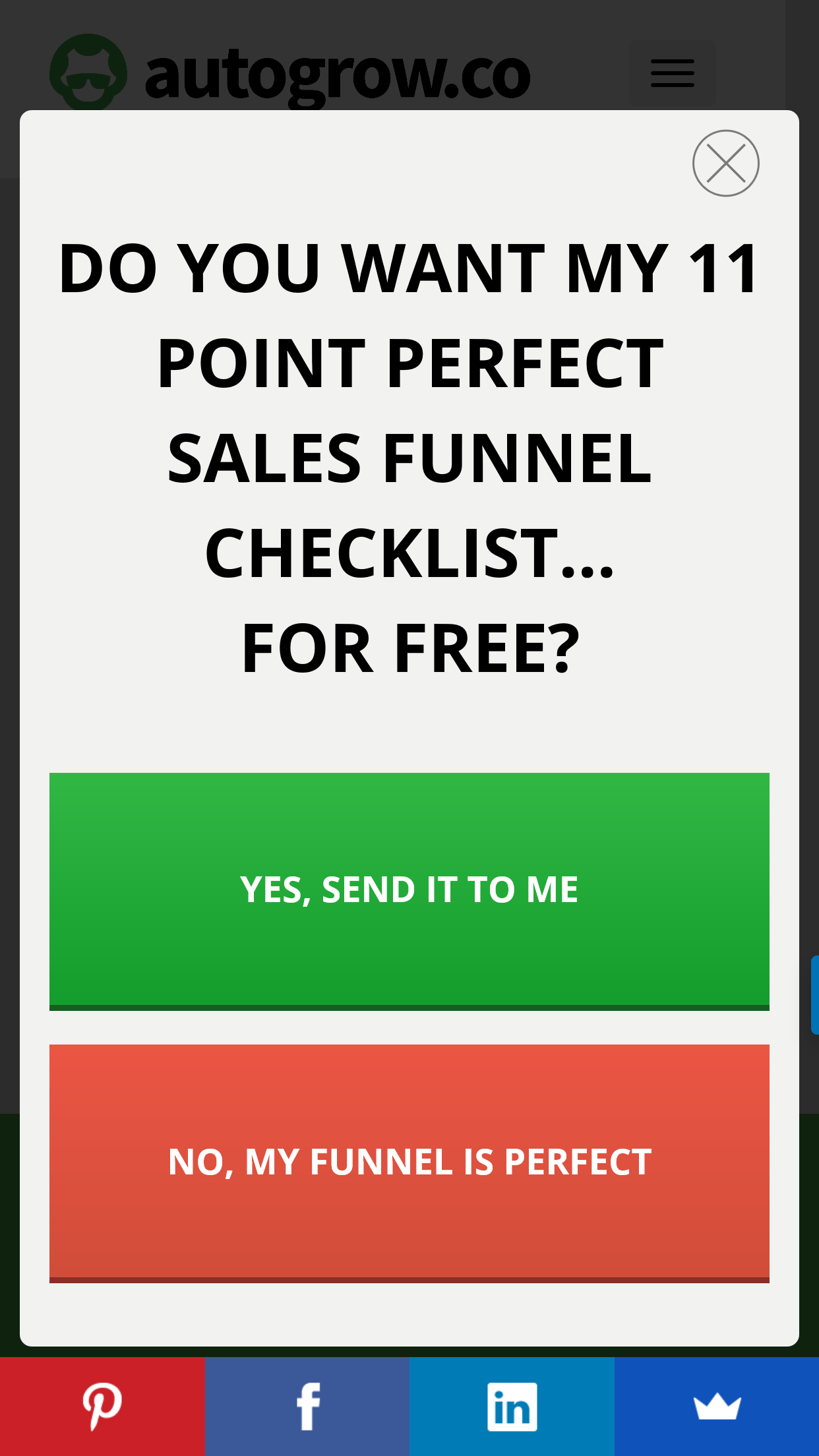 | List Builder – If your key goal is to capture email leads then every page of the site should be funneling traffic towards that. Pop up modals offering lead magnets, end of page call to actions and internal banners offering valuable content in exchange for the visitors email. |
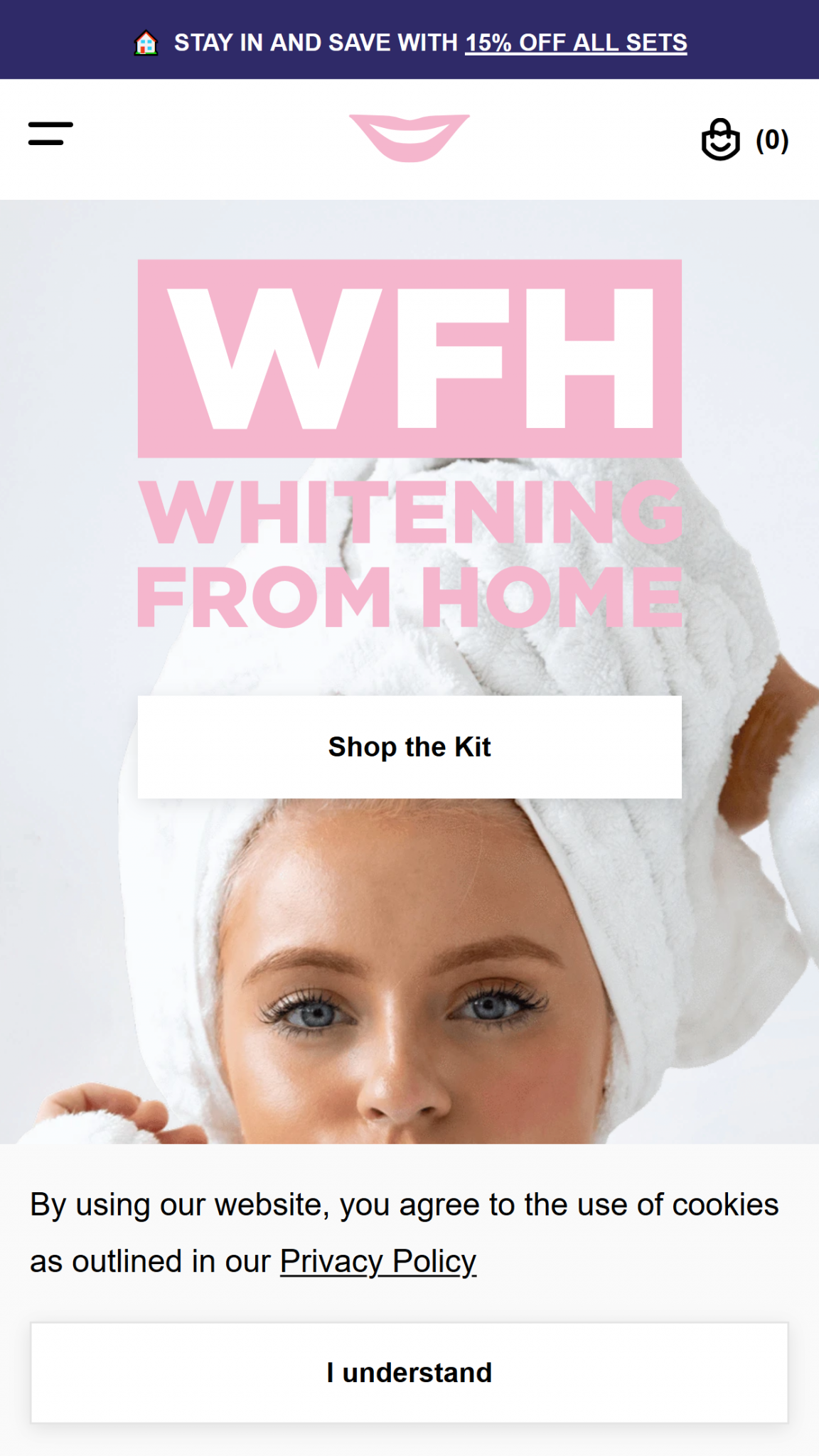 | E-commerce Sites – Nine times out of ten I’d recommend Shopify for ecom sites. It takes care of complex things like tracking goals, payment gateways, shopping cart and checkout process. New shopify stores get 30 days free to test a concept before an affordable $29 monthly fee. |
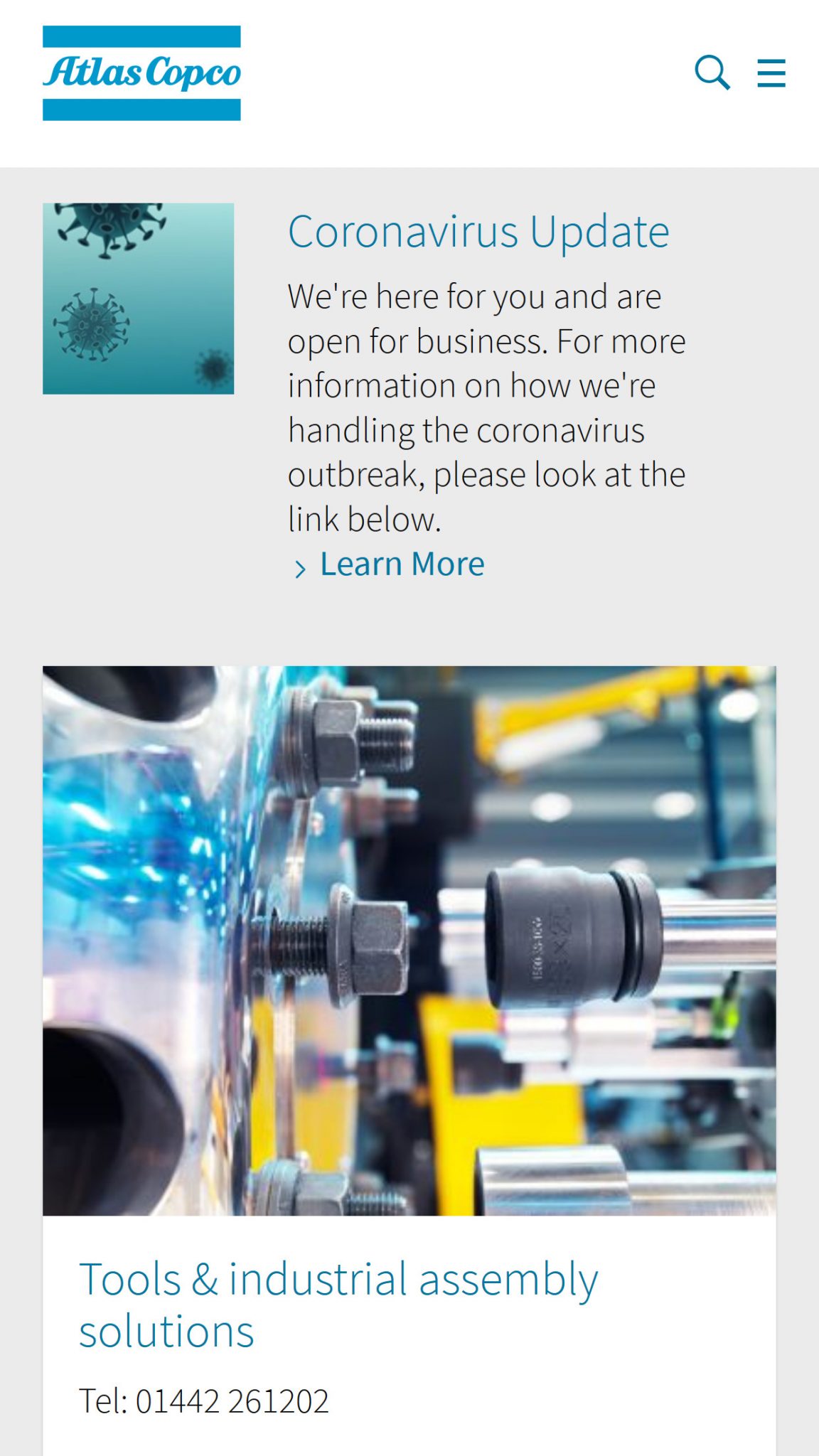 | Corporate Sites – a corporate site is used primarily as a digital representation of the company. It is less performance focused but more effort should be put into the design and professionalism of the design. WordPress is a good choice as it enables non-technical employees and founders to edit and update the site themselves, hopefully adding content on a regular basis. |
Banner Design
Banner design is a science more than an art. When running banner ads you can test a lot of variations very quickly as you can get 1000 impressions in tier 3 countries for $0.10 on some non-premium ad networks. Want to learn how to design great banners, buy some ads > test > develop > test some more.
Split testing banners never ends. Performance marketers will almost never upload a single ad for a campaign. The process goes from completely different but technically good banners to narrowing down to variations on a theme for the best performing ads.
Tips for designing banner ads
- When bidding cost per click focus on isolating the target demographic for the best possible value and engagement per click.
- When bidding cpm focus primarily on click through rate to get as many clicks per 1000 impressions as possible.
- Always include a call to action, normally a button. “Continue” or “Buy Now” work well as a starting point for button text.
- Space is limited but don’t try to crowd too much in and compromise on the design. The banner needs to look good enough to click.
- Test different angles and headlines to get higher metrics but also to learn insights into what your potential customers want.
- Find the banners that are competing the best on the targeted traffic source and use them as a template to work from and improve upon.
Video Design
On platforms like facebook video ads generally perform better than banners. A well marketed video ad can tell a much more compelling story in the same digital ad space as a banner.
Video ads can either be outsourced to an agency or va but you can quite easily design them yourself. Amateur videos work great in the same way ugly banners worked well 10 years ago. People relate to videos that look like they were created by people rather than companies.
There is a great, free video editing software package called DaVinci Resolve. This can be used with stock videos and music to overlay titles and produce a high converting video ad.
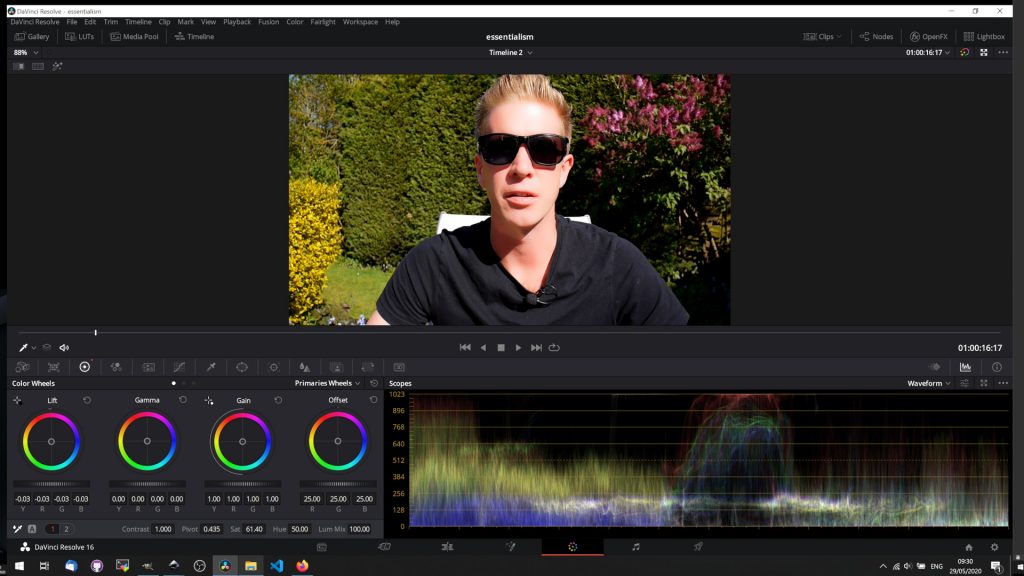
Some websites for stock video footage:
https://www.pexels.com/videos/
And some places to find audio & background music
GroovePad mobile app – Android / Apple
https://www.youtube.com/audiolibrary/
Within DaVinci Resolve you can mix these components together in the editing section and then drag and drop “titles” and “lower thirds” onto the scenes for overlaid text.
End the video with a call to action. Clearly communicate to the user what they need to do next.
Optimisation
Online marketing is all about optimisation and continuous improvement to the efficiency of a campaign. Everything is tested that can be, to search for pockets of profitable traffic. Once discovered profitable campaigns are scaled up to increase volumes and profit.
How to optimise a online marketing campaign
You can test multiple things at once known as multivariate testing or test a couple of variations of an element known as AB testing. I recommend starting with the factors that have the greatest impact and working from there.
If you are optimising a sales funnel then start by building out tests for the first stage. This is where you’ll have the most data and it will be quickest to get measurable results. This could mean testing different traffic sources or running a variety of ads on a specific network.
One of the most important factors is your core value proposition. What is it that you are selling and how does the consumer benefit? This should be split tested early on to try and find a product market fit for what you are doing. Often the value proposition is displayed in the headline of a landing page which is one of the easiest things to split test as well.
When entering a new niche it may be worth testing a variety of business ideas to learn about demand in that niche. Do consumers want an e-commerce store or a subscription service? How does that fit in with your customer acquisition and lifetime revenue figures? Testing will give you this data before you commit to a project.
Once you have a value proposition that works you can run look for angles which are different ways of conveying the value you are offering. An angle might be asking a thought provoking question which pushes emotional triggers, it could be a news style article or a blog post, it could be a discount offer or anything else that changes the perception and increases the conversion rate of the offer.
When the fundamentals are in place it is then time to start testing design aspects. I recommend starting broad with at least 3 completely different landing pages. The only similarity being that they use the same value proposition and angle that was previously tested.
One landing page will perform best and the marketer can then start work on testing different design aspects from photos, videos, colours, borders, menus and text layouts.
A/B testing it is often seen as changing the colour of a button and magically increasing landing page performance by 10%. This does happen but more often than not it is variance, due to optimising on small data sets. Try running a split-test every now and again for the exact same thing to see how much variance you get and see if you would have over optimised the result.
Optimising well leads to better performing campaigns which compete to gain more volume and ultimately earns more profit. Mastering this process is key for every online marketer and it’s a constant learning process.
Monetisation
How do online marketers monetise the traffic coming in to a website, landing page or app? Normally a campaign will be set up with a vague idea of where the traffic will come from and a clear idea of how it will be monetised. Let’s look at some examples of how to monetise online visitors aka traffic.
Ways to Monetise Traffic & Make Money Online
Affiliate Offers
There are thousands of companies including big names like Amazon and eBay who will pay you a percentage of a sale. Marketers can direct traffic to 3rd party websites via tracking links and earn affiliate payments if the user goes on to buy something from that site.
There are also CPA (cost per action) offers where the affiliate gets paid a fixed price for every user that signs up or downloads an app. Cost per call offers where payment goes out after a user has phoned the vendors call center and is registered as a lead. And revenue share offers which differ slightly from commissions in that the affiliate will get paid a high percentage (sometimes 90%) on the sale of digital products like eBooks and online courses.
There’s more information here on affiliate marketing.
E-Commerce
If you have something to sell then it makes sense to setup a store and funnel traffic into the store selling your own products. Shopify stores have boomed as drop shippers and print on demand marketers have competed over a growing marketplace.

Advertising
The advertising model relies on getting low cost or free organic traffic from SEO and social media. Or alternatively having a site/app with a viral aspect where you can get a constant flow of clients without paying customer acquisition costs. Ads can then be placed on your website and you’ll receive monthly payments from the ad network. It’s quite common for online marketers to be both buying and selling ads at the same time as they may have an offer for one niche and a website for another.
Subscription Services
Subscription revenues provide a constant steady stream of income making business and cash flow very predictable. A consumer will usually get a free trial and then pay a fixed monthly fee for access to software (SaaS or Software as a Service), a community, or premium content and online courses.
Building long-term revenue streams
Everyone coming into online marketing at the start wants to get rich quick and it’s certainly possible. Affiliate campaigns can be scaled up within weeks from nothing to six figure a month campaigns. A viral social media post could bring in an influx of sales and new customers. What is better than this though is building long term passive income.
When doing online marketing something always goes wrong. It could be a problem with an ad exchange, an algorithm change at Google, an affiliate offer going down. If you aren’t constantly moving forwards then you’ll be left behind.
The ultimate goal for many online marketers and myself included is to build consistently valuable areas of online real-estate which bring in growing amounts of passive income.
To achieve this we must look at long-term projects in niches that will be around and wont grow saturated or lose interest. The best niches to work on in my opinion are scalable ideas in new up and coming sectors where there’s no authoritative competition and growing demand for information, content, products and services.
Thinking about the future and how the world is changing can come up with ideas but my favourite technique is to just be aware of opportunities as they arise. The first time you hear about something intriguing, a new technology or the latest consumer trend, that’s the time to start developing a campaign.
Look at how best to grab attention through advertising and how then to monetize a captivated audience and add value across the user journey.
Challenges Scaling Up
Ramping up volumes on a campaign can cause issues from a technical perspective and business organisational problems.
Technical Scaling Considerations
The back-end service of a site or app is usually what breaks first. Inevitably when something is first designed it is built to run on a single server and if you need to distribute it across multiple servers and use load balancers the backend code will need modifying.
We can mitigate this by using storage solutions that are designed to scale. Databases like MongoDB and REDIS are proven and work well at high volumes. As the project grows larger it may be necessary to break up datasets across multiple data storage servers.
At high volume the SaaS products you were using may need to be swapped out for in house solutions. 3rd party tracking systems, email delivery services and landing page creators all become inadequate and uneconomical at really high volume.
Sites should be built as lean as possible, compressing images and minifying code can save a lot of money on bandwidth costs.
Organisation Scaling Considerations
How does a company grow exponentially while still delivering the same quality of service? Can the support team be expanded quickly? Does the product fulfillment still work at high volume? Can the manufacturer keep up with demand to avoid refunding late orders?
Problems like this are great to have but sometimes it doesn’t seem like it when you are constantly putting out fires.
One of the most important things to consider is tax planning. If you are making a lot of money it’s critical that you effectively manage your tax efficiency or you will end up having to give the majority of it to a central government. I’m not saying don’t pay tax but get advice on the most efficient way to protect your profits. Normally this involves setting up a company.
Online Marketing In A Corporate Team
Bringing a data-centric approach to a corporate marketing team will give you a head start over many competitors. In many sectors it’s still rare to see effective and efficient marketing even at blue chip companies.
The days of big brands throwing money at digital advertising without even considering kpi’s is probably over but there’s still a lot of money wasted at this level. How many companies in the SP500 could actually tell you how much of their ad spend is wasted on bots? Many marketing teams probably wouldn’t even be aware of the issue.
Take a test everything approach and your campaigns will be more effective. Set about learning the skills outlined in this document and you’ll become an invaluable asset to the company.
Independent Online Marketing
If you can run online marketing campaigns at competitive levels why wouldn’t you want to work for yourself? There are literally thousands of ways to make money online for effective marketers. Let’s look at some of the most popular (and competitive).
Affiliate Marketing
Normally the first step for most online marketers after they’ve setup a few Adsense sites. Affiliate marketing is scalable almost indefinitely and top performing affiliates are rewarded according to the volumes and quality of traffic they provide.
Affiliate life is normally a roller coaster ride as offers come and go, ad networks ban accounts that push too hard on their advertising guidelines and affiliate networks continually go bust owing affiliates millions in payouts.
It’s a “get rich quick” industry and there are more people offering to teach how to make money than there are actually making money. Avoid the gurus, learn by running offers, testing traffic sources and failing repeatedly until you hit a profitable campaign that scales well.
Print on Demand

TeeSpring fired the PoD industry into the spotlight and performance marketers flocked to it around 2015. Print on Demand works by creating a custom design, this will be superimposed on to a product such as a t-shirt. The marketer will promote this product and when they get a sale the PoD company will print the item and ship it.
Drop Shipping
I wonder who first figured out they could sell stuff from China as their own products and then fulfill the order by just putting the customers delivery address in while ordering it from AliExpress.
Today drop-shipping is a huge industry and the lines are blurred between what qualifies as an independent dropshipper and full on branded product companies that just have manufacturers in China.
The current method involves building single product branded shopify stores for trending “wow factor” products. Customer satisfactions is hit and miss and the scaling eventually leads to local fulfilment or FBA (fulfillment by Amazon).
Drop Shipping provides a lean method of testing e-commerce without committing huge budgets to stocking and manufacturing products.
Made For Adsense Websites
Sites that generate consistent ad revenues are a true source of passive income. A great site can run on auto-pilot for years without any interaction. Although like everything the truth behind the dream is that passive-income is relative and there’s always improvements to be made, content to be built, connected social media accounts to manage and designs to tweek.
MFA sites focus on SEO to get free search engine traffic which is monetized through selling ads. This is a long-term project although some marketers and developers build and sell sites on platforms like Flippa which is a good place to do research on the type of MFA sites that are doing well.
Competing At The Highest Levels
There’s never an end point to effectively running online marketing campaigns. A banner can always get more clicks, a landing page can be optimised and an offer can be rotated. Aside from that the marketing landscape is forever changing as new technologies, sites, apps and opportunities come and go. There is always something new to learn and new areas to explore.
Building Brands
Independent online marketers hate competing with brands. For years this was the vain of my life as they didn’t consider metrics, the marketing wasn’t effective but they just brought up the majority of traffic anyway with larger budgets and no regard to performance.
Brands can out compete independent marketers because the power of the brand enables them to make more lifetime value on the backend. If you have the dominant brand for an industry then your company becomes the default option for new customers. You’ll get more word of mouth recommendations, more backlinks, more organic traffic (Google loves brands) and higher revenues which can be directed to larger marketing budgets.
If you have an opportunity to work on something long term and are creating a great product or service then combine it with great branding to dominate the niche.
Programmatic Ad Buying
Programmatic advertising involves a computer programme acting as a bid manager on an ad exchange. The ad exchange will ping the server the visitor data such as browser, ip address, cookie data and then the bidder decides if it wants to bid on that ad impression. The bid is calculated within a fraction of a second and the highest bidder wins the impression.
This is how ad exchanges have operated for a long time but it’s becoming more common for independent affiliates and direct advertisers to use the openRTB specs and open source software like RTBkit to create their own bidding systems. High budgets are required for most exchanges but margins can be improved as the advertiser gets more control over the traffic they are purchasing.
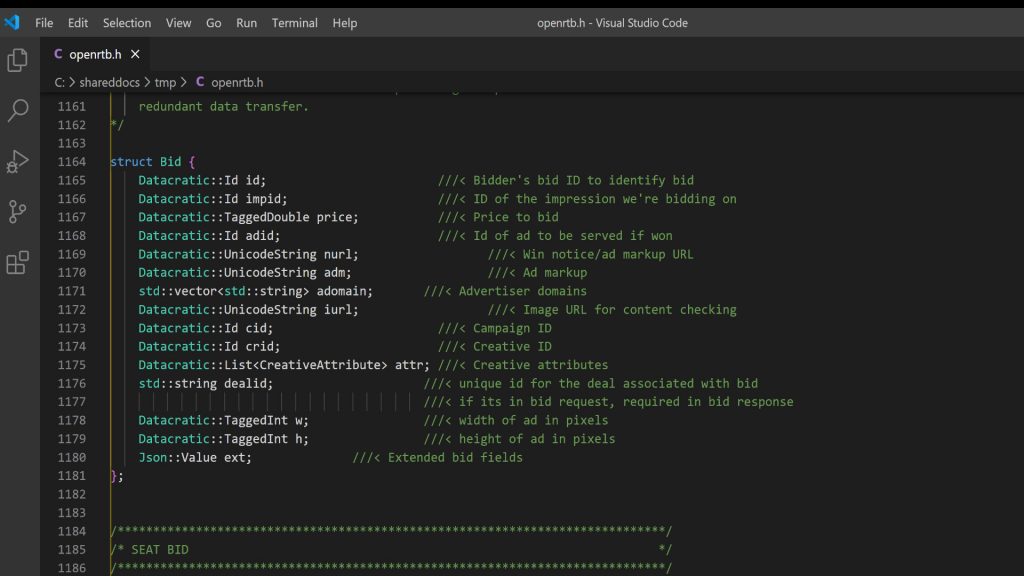
Leveraging Data
Performance marketing revolves around leveraging data to improve return on ad spend. At the highest levels data can be purchased via API queries from 3rd parties and used to improve the efficiency of advertising campaigns.
Imagine an average display campaign that has 20% of fraud/bot traffic. If you can use 3rd party data or internal systems to bring that figure down to 18% then you have an additional 2% profit on your bottom line.
Many social networks allow you to build audiences by uploading email lists. This makes having, purchasing or finding a targeted email list very valuable as you can target ads towards a specific audience that your competitors don’t have access to.
At a very basic level, geoIP and browser data can be used to further optimise campaigns. Certain regions outperform others, many campaigns work better in urban rather than rural environments. Using this data to narrow down geographic targeting can reduce volume but increase profits. The same can be done with browser data where Android users and iOS users tend to convert differently on certain offers for example. iOS users are more likely to make online and in-app purchases which makes that traffic more valuable to certain marketers.

What is Online Marketing?
Online marketing is the purchasing of digital advertising space to promote a product or service. Performance marketers continuously test all aspects of an advertising campaign to improve return on ad spend.
The online marketing industry is a fast moving and competitive environment. The best online marketers have a broad skill set and detailed knowledge and experience with various traffic sources. Over the last ten years that I have worked in the industry much has changed. Opportunities have come and gone but there is always an idea waiting to be tested, a niche that is prime for disruption or a campaign that can be further optimised.
This article is part of a free online course where you can learn digital marketing.
If you’ve enjoyed these resources could you help share this content on social media and send it to anyone who you think might benefit from it.
Thank you.


